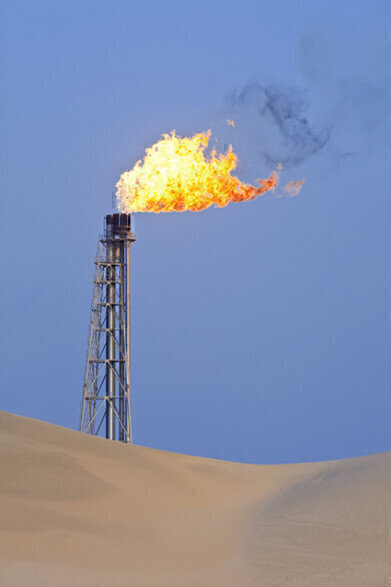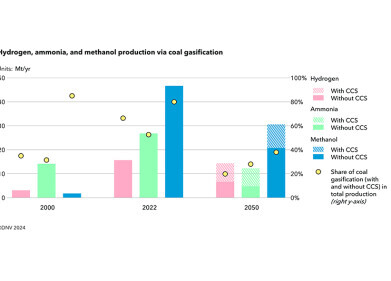-
 LNG is used as a low-emission marine fuel
LNG is used as a low-emission marine fuel -
 Historical process diagram showing ammonia absorption chilling
Historical process diagram showing ammonia absorption chilling -
 Gas flaring can be avoided by methane liquefaction to LNG
Gas flaring can be avoided by methane liquefaction to LNG
Green Energy
Waste heat to generate deep cold for LNG
Jul 30 2021
Author credit: Stephen B. Harrison, Managing Director, sbh4 consulting
Many industrial processes such as steel production, cement making and power generation result in ‘waste heat’. This is energy that is left over from the process but is available at lower temperature than can usefully be utilised.
There are many examples of how waste heat is recovered to ensure energy efficiency. For example, domestic condensing boilers recover low grade heat from the combustion flue gases to pre-heat the returning central heating water optimise their energy efficiency for space heating applications.
Another application of waste heat recovery is the use of high temperature heat pumps to elevate the temperature of waste heat to a useful level. For example, to generate steam at 120 °C from waste heat at only 80 °C. Alternatively, the concept of process integration means that waste from one process is used as a useful input to another.
A fascinating utilisation of waste heat is to drive a refrigeration cycle to create deep cold temperatures. The ammonia / water absorption cycle is the technology that makes this possible. The operating principle relies on ammonia being highly soluble in cold water, but less soluble in hot water. A pump is used to recirculate an ammonia in water solution from a cold reservoir to one where the mixture is heated, ideally using waste heat from another process.
As the mixture of ammonia in water is heated, ammonia is driven into the vapour phase at high pressure. The high-pressure ammonia can then be used in a classical condenser, expansion valve and vaporiser refrigeration cycle. Ammonia gas is then returned to the cold-water bath where it is absorbed into the water. The cold-water bath is chilled by heat exchange against cooling water to remove the heat energy from the refrigeration system.
Ammonia absorption chillers are being implemented for natural gas liquefaction by the Canadian start-up Cool Science. Their founder, and inventor of their patented system, Colin Nikiforuk says that “in contrast to classical vapour compression refrigeration cycles, the energy inputs are power for a pump and heat. The electricity demand, cost and maintenance requirements for the pump are less that those that are required for a gas compressor. The system can therefore offer cost savings and energy efficiency benefits.”
Liquefaction of natural gas using ammonia absorption chillers
Classical refrigeration cycles that are used for LNG liquefaction rely on electrical power and mechanical compression energy as the inputs to the refrigeration cycle. The cold is achieved when hot compressed gases are cooled and then expanded. However, electricity is consumed, and power is not always abundant in locations where natural gas or biomethane must be liquefied to LNG. This is especially true for small scale LNG plants that may be in remote locations, away from the electricity transmission grid.
The use of locally produced electricity from renewables to drive a mechanical refrigeration cycle may be possible but would require good sunlight or wind conditions. “In many places where methane liquefaction is required, such as Canada, we have neither the sunlight intensity nor the wind conditions that are required for renewable wind and solar power generation” says Nikiforuk.
“This is where the benefit of the ammonia absorption process comes to the fore – it can use waste heat from nearby processes, instead of electrical power, to drive the refrigeration cycle.” Process integration allows energy efficiency, operating cost savings and contributes to environmentally sustainable LNG production.
LNG is used in a diverse range of applications. Beyond its primary roles as being a major traded international commodity for regasification and power generation, shipping is increasingly turning to LNG as a low-emissions bunker fuel to comply with maritime air quality requirements. Liquefaction of excess methane to make LNG in upstream oil and gas operations is also an alternative to flaring, which simply burns excess methane releasing carbon dioxide emissions to the atmosphere without recovering the energy value of the natural gas.
Turbo-charged technology
The basic technology related to ammonia / water absorption chillers has been known for 160 years. The earliest patent on the topic was prepared by the French inventor Ferdinand Caré in 1860. “Our innovations have made the process that Caré conceived more robust to operate and enable a lower temperature to be achieved, which means the technology can be applied to gas liquefaction and small-scale LNG”, says Nikiforuk.
Cool Science has cemented their developments in a comprehensive patent, which has been granted in many jurisdictions. The system can cope with a broad range of ammonia purities and has minimal control points which makes is very easy to operate.
Nikiforuk adds that “we have turbo-charged a technology that is more than a century old through implementation of modern engineering and process control fundamentals. It builds on best practices that we have observed in similar processes in the refining sector.”
Events
May 05 2024 Seville, Spain
May 13 2024 Munich, Germany
May 23 2024 Beijing, China
May 23 2024 Beijing, China
Jun 10 2024 Algiers, Algeria













